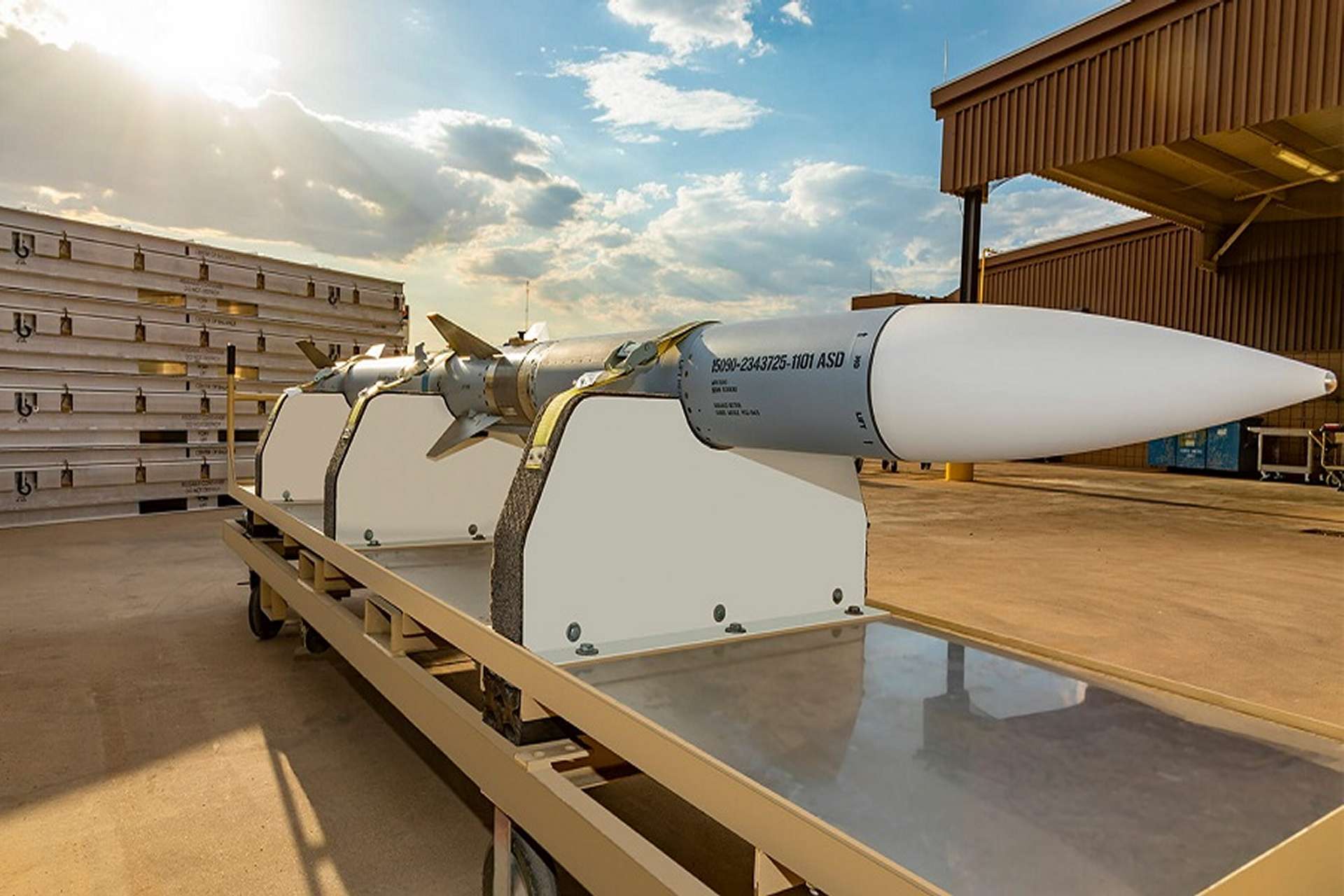Türkiye’s Fighter Jets to Gain Enhanced Air Combat Edge with AIM-120C-8 Missiles Acquisition

{loadposition bannertop}
{loadposition sidebarpub}
On May 14, 2025, the U.S. State Department approved a potential Foreign Military Sale to the Republic of Türkiye of AIM-120C-8 Advanced Medium-Range Air-to-Air Missiles (AMRAAM), a product developed by RTX Corporation, a leading American defense contractor. Positioned within the category of beyond-visual-range air-to-air missiles, the AIM-120C-8 contributes directly to modern air dominance strategies, enabling allied air forces to intercept and destroy airborne threats with precision and flexibility.Follow Army Recognition on Google News at this link
The approval of the AIM-120C-8 missile sale to Türkiye represents a calculated step toward enhancing NATO’s collective aerial combat readiness in a volatile region (Picture source: RTX)
The AIM-120C-8 is one of the most advanced iterations of the AMRAAM missile family, offering substantial improvements in range, seeker precision, and electronic counter-countermeasures. According to publicly available data and coverage by Army Recognition, the AIM-120C-8 builds upon the capabilities of earlier C-model variants by integrating hardware and software upgrades derived from the AIM-120D program, while remaining export-compliant for allied use. Designed for deployment from fighter aircraft such as the F-16, F-15, F/A-18, and newer platforms like the F-35, the missile has a range exceeding 160 kilometers under optimal launch conditions, and is guided by an active radar seeker in conjunction with inertial navigation. Its ability to engage multiple targets beyond visual range, even in contested electronic environments, makes it one of the cornerstones of modern Western air superiority doctrines.
The relevance of this transaction extends beyond its military value, it touches on critical NATO defense commitments, the integration of Türkiye within the Western defense industrial base, and the evolving structure of regional air deterrence architecture. At $225 million, this sale signals renewed cooperation between the U.S. and Türkiye in a period marked by both collaboration and friction, offering a potent reminder of Türkiye’s irreplaceable geographic and military role in NATO.
Operationally, the AMRAAM missile family has been fielded since the early 1990s and has seen extensive use across multiple air forces, accumulating thousands of test and operational firings. The C-8 variant, introduced as an enhanced export version, benefits from iterative improvements derived from combat feedback and test programs conducted by the U.S. Air Force and Navy. Its development is embedded within RTX’s long-standing partnership with the U.S. Department of Defense and foreign partners, balancing technological evolution with production scalability. Türkiye, already operating earlier versions of AMRAAM, will be able to integrate the C-8 with its existing fleet of F-16C/D aircraft, many of which are undergoing avionics and radar upgrades.
Compared to legacy medium-range missiles such as the AIM-7 Sparrow or Russian R-27 variants, the AIM-120C-8 provides greater kill probability, better resistance to electronic jamming, and all-weather targeting capabilities. Within the broader AMRAAM evolution, the C-8 offers incremental but crucial improvements over the C-5 and C-7 versions, notably in kinematic performance and mid-course guidance. While the European Meteor missile, developed by MBDA, may offer superior range and a ramjet propulsion system, it is generally more expensive and less compatible with legacy platforms, making the AIM-120C-8 a balanced and widely interoperable solution for NATO-aligned air forces.
Strategically, the AIM-120C-8 sale to Türkiye has both military and geopolitical ramifications. Militarily, it strengthens Türkiye’s ability to maintain air superiority over its national airspace and contested buffer zones such as the Eastern Mediterranean, Northern Syria, and the South Caucasus. Geopolitically, it affirms the continued defense alignment between Ankara and Washington despite ongoing political divergences. The reinforcement of Türkiye’s missile stockpile with a NATO-standard weapon also sends a message to regional adversaries, particularly in a context of rising tensions with neighboring air forces, including Russian and Iranian-backed operators.
The approval of the AIM-120C-8 missile sale to Türkiye represents a calculated step toward enhancing NATO’s collective aerial combat readiness in a volatile region. For Türkiye, it is both a tactical upgrade and a signal of renewed defense engagement with the U.S. defense industry. With threats becoming faster, more complex, and more contested, precision-guided weapons such as the AIM-120C-8 are not merely optional tools, they are essential assets for any country seeking to secure its airspace and deter aggression through credible force projection.

{loadposition bannertop}
{loadposition sidebarpub}
On May 14, 2025, the U.S. State Department approved a potential Foreign Military Sale to the Republic of Türkiye of AIM-120C-8 Advanced Medium-Range Air-to-Air Missiles (AMRAAM), a product developed by RTX Corporation, a leading American defense contractor. Positioned within the category of beyond-visual-range air-to-air missiles, the AIM-120C-8 contributes directly to modern air dominance strategies, enabling allied air forces to intercept and destroy airborne threats with precision and flexibility.
The approval of the AIM-120C-8 missile sale to Türkiye represents a calculated step toward enhancing NATO’s collective aerial combat readiness in a volatile region (Picture source: RTX)
The AIM-120C-8 is one of the most advanced iterations of the AMRAAM missile family, offering substantial improvements in range, seeker precision, and electronic counter-countermeasures. According to publicly available data and coverage by Army Recognition, the AIM-120C-8 builds upon the capabilities of earlier C-model variants by integrating hardware and software upgrades derived from the AIM-120D program, while remaining export-compliant for allied use. Designed for deployment from fighter aircraft such as the F-16, F-15, F/A-18, and newer platforms like the F-35, the missile has a range exceeding 160 kilometers under optimal launch conditions, and is guided by an active radar seeker in conjunction with inertial navigation. Its ability to engage multiple targets beyond visual range, even in contested electronic environments, makes it one of the cornerstones of modern Western air superiority doctrines.
The relevance of this transaction extends beyond its military value, it touches on critical NATO defense commitments, the integration of Türkiye within the Western defense industrial base, and the evolving structure of regional air deterrence architecture. At $225 million, this sale signals renewed cooperation between the U.S. and Türkiye in a period marked by both collaboration and friction, offering a potent reminder of Türkiye’s irreplaceable geographic and military role in NATO.
Operationally, the AMRAAM missile family has been fielded since the early 1990s and has seen extensive use across multiple air forces, accumulating thousands of test and operational firings. The C-8 variant, introduced as an enhanced export version, benefits from iterative improvements derived from combat feedback and test programs conducted by the U.S. Air Force and Navy. Its development is embedded within RTX’s long-standing partnership with the U.S. Department of Defense and foreign partners, balancing technological evolution with production scalability. Türkiye, already operating earlier versions of AMRAAM, will be able to integrate the C-8 with its existing fleet of F-16C/D aircraft, many of which are undergoing avionics and radar upgrades.
Compared to legacy medium-range missiles such as the AIM-7 Sparrow or Russian R-27 variants, the AIM-120C-8 provides greater kill probability, better resistance to electronic jamming, and all-weather targeting capabilities. Within the broader AMRAAM evolution, the C-8 offers incremental but crucial improvements over the C-5 and C-7 versions, notably in kinematic performance and mid-course guidance. While the European Meteor missile, developed by MBDA, may offer superior range and a ramjet propulsion system, it is generally more expensive and less compatible with legacy platforms, making the AIM-120C-8 a balanced and widely interoperable solution for NATO-aligned air forces.
Strategically, the AIM-120C-8 sale to Türkiye has both military and geopolitical ramifications. Militarily, it strengthens Türkiye’s ability to maintain air superiority over its national airspace and contested buffer zones such as the Eastern Mediterranean, Northern Syria, and the South Caucasus. Geopolitically, it affirms the continued defense alignment between Ankara and Washington despite ongoing political divergences. The reinforcement of Türkiye’s missile stockpile with a NATO-standard weapon also sends a message to regional adversaries, particularly in a context of rising tensions with neighboring air forces, including Russian and Iranian-backed operators.
The approval of the AIM-120C-8 missile sale to Türkiye represents a calculated step toward enhancing NATO’s collective aerial combat readiness in a volatile region. For Türkiye, it is both a tactical upgrade and a signal of renewed defense engagement with the U.S. defense industry. With threats becoming faster, more complex, and more contested, precision-guided weapons such as the AIM-120C-8 are not merely optional tools, they are essential assets for any country seeking to secure its airspace and deter aggression through credible force projection.





